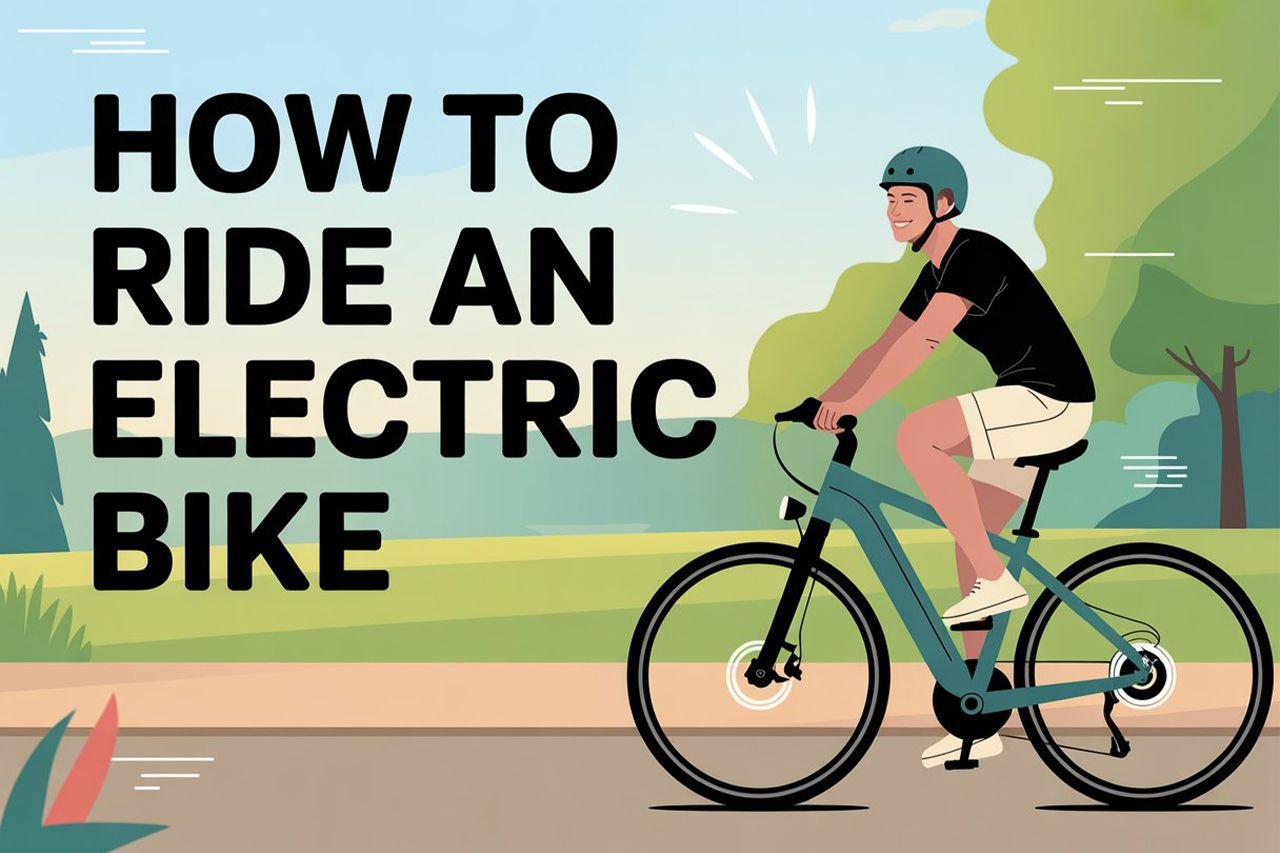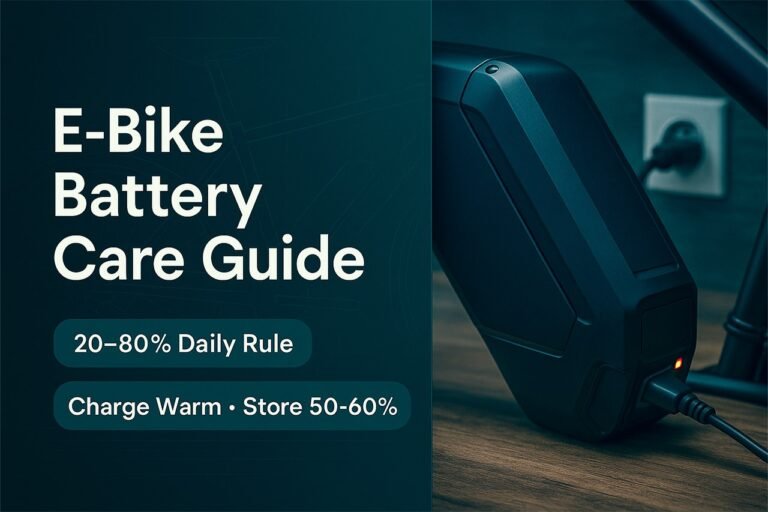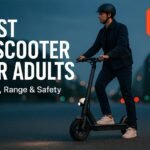
If you’re here, you’re probably wondering how to ride an electric bike—and I totally get it! E-bikes look a little different, feel a little different, and honestly, open up a whole new world of cycling. Whether you’re brand new to bikes, coming back after a long break, or you’re just curious about making your commute a breeze, this guide is for you. We’ll break it all down, step by step, with honest, practical advice—just like if you asked a cycling buddy over coffee.
These are the basic steps you’ll follow:
- Get to know your e-bike and its controls.
- Set up your bike for comfort and safety.
- Find a safe space and practice starting, stopping, and basic riding.
- Learn how to use pedal assist, throttle, and gears smoothly.
- Master safe riding habits, braking, and turning.
In the rest of this guide, I’ll take you through each of these steps in detail, answer common questions, and share tips that’ll help you feel confident and safe every time you ride your e-bike—whether you’re zipping around town, exploring new trails, or just heading to the store.
What You’re Going to Need
Let’s start with the basics. Before you even hop on, here’s what you’ll want to have ready:
- Your electric bike (fully charged)
- A good, properly fitted helmet (non-negotiable!)
- Comfortable clothes (avoid baggy pants or anything that can catch in the chain)
- Closed-toe shoes (sneakers are perfect)
- Gloves (optional, but great for grip and protection)
- A safe, open space to practice (like an empty parking lot, quiet street, or park path)
- Water bottle—staying hydrated is part of riding a bike safely
Optional but smart: bike lights, a bell, and reflective gear.
Video Tutorial
Some people learn best by watching. If that’s you, I highly recommend this video for a solid visual overview before you dive into the details:
This short video walks you through the essentials of riding an e-bike safely—from setup to first ride. If you’re a visual learner, you’ll love how clearly it demonstrates each step in a real-world setting.
Step 1: Get to Know Your E-Bike
Okay, let’s get comfortable! Every electric bike is a little different, but almost all have a few things in common—let’s walk through them.
Meet Your E-Bike’s Controls
- Power Button
Most e-bikes have a clear on/off button—usually on the frame, battery, or the display panel. Get used to turning it on and off. - Display/Control Panel
This little screen (usually on your handlebars) shows speed, battery level, pedal assist mode, and sometimes trip distance. - Pedal Assist (PAS) Controls
Usually, there are “+” and “-” buttons to raise or lower the pedal assist. Lower means less motor help, higher gives you more boost with each pedal stroke. - Throttle (if equipped)
Some e-bikes have a throttle—think of it like a scooter or moped. Twist or push the throttle and the bike goes, even if you’re not pedaling. - Gears
Just like a regular bike, many e-bikes have gears to make pedaling easier or harder. Shifting is especially useful on hills or for getting up to speed smoothly. - Brakes
Most e-bikes use disc brakes, which are strong and reliable. Practice using both front and rear brakes for controlled stops.
Pro tip:
Take a few minutes to just sit on the bike, turning things on and off, clicking the pedal assist up and down, and squeezing the brakes (with the bike stationary). It helps everything feel less intimidating!
Why This Step Matters
Learning how to ride an e bike safely starts with knowing your machine. If you get comfortable with the buttons, levers, and screens, you’ll be less distracted and more confident when you start rolling.
Step 2: Set Up for Comfort and Safety
Before you take your first ride, make sure the bike fits you and everything is secure.
Adjusting Your Seat
- Stand next to your e-bike. The seat should be about level with your hip bone.
- Sit on the seat and place your heel on a pedal at its lowest point. Your leg should be almost straight, with a slight bend at the knee.
- When you pedal normally (with the ball of your foot on the pedal), your knee should never fully lock out.
A seat that’s too low wastes energy and can cause knee pain; too high and you’ll be rocking side to side—awkward and unsafe.
Adjusting Handlebars
- You want your back straight but not stiff, elbows slightly bent, and a relaxed grip.
- Higher handlebars are more comfortable for most beginners, but some prefer them lower for sporty rides.
Safety Checks
- Squeeze both brakes—do they feel firm?
- Check that the wheels are secure and the tires are properly inflated.
- Ensure the battery is locked in place.
- Test lights and the bell/horn.
This pre-ride check is one of the best habits for anyone learning how to ride a bike safely.
Step 3: Practice in a Safe, Open Area
Time to get moving—but don’t head for busy roads just yet. Find a quiet, flat space where you can focus.
Mounting Your E-Bike
- Stand on the left side of your bike.
- Hold both brakes and swing your leg over the saddle.
- Sit down, keeping at least one foot flat on the ground for balance.
Starting Up
- Turn on the bike and select the lowest pedal assist level (often “Eco” or “1”).
- Place one foot on a pedal in the 2 o’clock position.
- Push off smoothly while releasing the brakes and begin pedaling.
The motor will gently kick in—don’t worry if it feels strange at first!
Getting a Feel for the Ride
- Start with low speed and low power until you’re comfortable.
- Practice stopping and starting several times. Remember, electric bikes are heavier than regular bikes and will take a bit longer to stop.
Balance and Control
- Look ahead, not down at your front wheel.
- Keep your arms loose and relaxed.
- Steer gently—oversteering is a common beginner mistake.
It’s totally normal to feel a little wobbly at first. Most people adjust quickly!
Step 4: Using Pedal Assist, Throttle, and Gears
This is where the magic of e-bikes really comes alive.
Pedal Assist Modes
- Low Assist:
Feels like a regular bike with a little help. Great for beginners and flat surfaces. - Medium Assist:
You’ll feel more of a push. Good for gentle hills or keeping up speed. - High Assist:
Makes you feel like a superhero. Save this for steep hills or headwinds.
Try switching between modes to see how the bike responds. Most of the time, you’ll be happiest somewhere in the middle.
Using the Throttle
- If your e-bike has a throttle, try it out in a straight, flat area.
- Gently twist or press the throttle to accelerate.
- Release to slow down (but always use brakes, too!).
Throttles are fun, but be careful—they can add speed quickly!
Shifting Gears
- Downshift to an easier gear before stopping or climbing hills.
- Shift up to harder gears when you want to go faster on flat terrain.
- Never shift under heavy pedal pressure—it can strain the drivetrain.
Combining Everything
Learning how to ride an electric bike means getting used to how the motor, gears, and your own power all work together. Don’t rush; give yourself time to experiment.
Step 5: Master Safe Braking and Turning
This is key to how to ride a bike safely—and it’s even more important with an e-bike, since they’re faster and heavier.
Braking Techniques
- Use both brakes together, but apply more force to the rear brake (right hand in most countries).
- Squeeze smoothly and steadily—don’t grab or jam the brakes.
- Shift your weight back slightly when braking hard to avoid tipping forward.
Practice:
Set up cones or use painted lines in your practice area to simulate stopping at crosswalks or red lights.
Turning and Cornering
- Slow down before the turn.
- Look through the turn—where you look, you’ll go!
- Lean the bike gently, not your whole body.
- Keep pedals level and outside pedal down if you’re turning sharply.
Handling Traffic and Obstacles
- Always signal your intentions with hand signals.
- Ride predictably and stay visible.
- Watch for car doors, pedestrians, potholes, and other surprises.
Emergency Stops
- If you have to stop suddenly, stay calm, squeeze both brakes hard, and keep your weight low and back.
- Practice emergency stops so you’re ready if you ever need one.
Additional Safety Tips for Riding an E-Bike
Riding an electric bike safely goes beyond just balance and brakes. Here are habits that will keep you rolling safely for years to come:
Be Visible
- Wear bright or reflective clothing.
- Use lights—even in the daytime.
- Make eye contact with drivers whenever possible.
Follow Local Laws
- Know where you can (and can’t) ride an e-bike in your area.
- Obey traffic signals, stop signs, and all road rules.
- Use bike lanes where available.
Stay Alert
- Scan ahead and to the sides constantly.
- Assume drivers may not see you.
- Avoid distractions—no headphones or phone use while riding!
Check Your Bike Often
- Charge your battery after each ride.
- Inspect tires, brakes, and the drivetrain regularly.
- Tighten bolts and keep your bike clean.
Ride Defensively
- Always be prepared for the unexpected.
- Give yourself space to react.
- Never assume another road user sees you.
Step-By-Step: Your First Real Ride
Let’s put it all together with a sample “first ride” plan, from home to your local park or café.
1. Prep and Check
- Charge your battery fully.
- Check tire pressure and brakes.
- Dress for the weather, and wear your helmet.
2. Start Easy
- Choose a quiet route or a time with little traffic.
- Use a low pedal assist setting to warm up.
3. Ride Predictably
- Keep a straight line, signal well before turns.
- Stay in bike lanes or as far to the right as safe.
4. Practice Braking
- Try stopping at different speeds.
- Notice how much distance you need to stop safely.
5. Mix it Up
- Change pedal assist modes and gears on hills.
- Try a few gentle turns, then sharper ones.
6. End on a High Note
- When you reach your destination, turn off the power, lock your bike, and give yourself a high five!
Every ride gets easier and more fun. Pretty soon, you’ll wonder why you didn’t try e-bikes sooner.
Common Questions About How to Ride an Electric Bike
Is riding an e-bike harder than a regular bike?
Nope! If anything, it’s easier. The motor helps you get started, climb hills, and go farther with less effort. You’ll still want to practice starting, stopping, and balancing, but you’ll find the learning curve pretty gentle.
Do I need special skills to ride an e-bike?
If you can ride a regular bike, you can ride an e-bike. Just remember, e-bikes are heavier and faster, so give yourself extra stopping distance and practice with the controls.
Can kids or seniors ride e-bikes?
Absolutely! Many older adults love the freedom of e-bikes. There are even kid-sized models. Always choose a bike that fits the rider, and make sure everyone wears a helmet.
How fast do e-bikes go?
Most e-bikes in the US are limited to 20 mph (32 km/h) with throttle, or 28 mph (45 km/h) with pedal assist (Class 3). But you don’t have to go that fast—start slow!
What if my battery runs out?
You can still pedal your e-bike home, just like a regular bike. It’ll be a bit heavier, but not impossible.
Troubleshooting Tips for New E-Bike Riders
The bike feels too fast/scary!
Set the pedal assist to the lowest level and practice in a calm space until you feel comfortable. Remember, you control the power!
My bike is too heavy to handle
E-bikes do weigh more. Get used to handling the extra weight by practicing turns, stops, and walking the bike with the motor off.
I keep accidentally hitting the throttle
If your bike has a throttle, be extra careful where you rest your hand. Some bikes let you disable the throttle—check your manual.
The battery drains quickly
Lower the assist level, pedal more, and keep your tires properly inflated. Cold weather also affects battery life.
Taking Your E-Bike on the Road: Safety in Traffic
When you’re ready to ride on real roads, here are a few advanced tips:
- Always signal your turns and stops.
- Ride defensively—expect the unexpected.
- Don’t weave between cars or up on sidewalks unless local laws allow.
- Leave space for doors to open when passing parked cars.
- Use your bell or horn to alert others politely.
E-Bike Etiquette: Sharing Paths and Trails
- Yield to pedestrians.
- Slow down near others, especially kids or dogs.
- Announce yourself (“On your left!”) when passing.
- Respect nature—don’t ride off marked trails.
Upgrading Your Ride: Accessories and Customization
Once you’re confident with how to ride an e bike, you might want to add:
- A better saddle for longer rides
- Panniers or baskets for carrying stuff
- A mirror for extra safety
- A phone mount for GPS
- Puncture-resistant tires
Maintenance Basics: Keep Your E-Bike Safe and Smooth
- Charge your battery after every ride.
- Clean your bike—especially the chain and drivetrain.
- Check brakes and tire pressure weekly.
- Have a professional tune-up at least once a year.
The Joy of E-Bike Riding
Once you master the basics, riding an electric bike can genuinely change your life. You’ll explore farther, ride longer, and get more out of every journey—without worrying about hills, headwinds, or tired legs. And when you ride safely and confidently, you’ll inspire others to give it a try too.
Final Thoughts
We’ve covered everything you need to know about how to ride an electric bike—from getting to know your controls, setting up your bike, and practicing in a safe space, to mastering pedal assist, braking, turning, and handling real-world traffic. The more you ride, the better you’ll feel.
Remember: Safety, confidence, and a little practice are all you need. If you ever feel unsure, take a step back and practice in a quiet space. Every e-bike rider started as a beginner—including me!
So charge up, strap on your helmet, and get out there. The road—and a whole new world of cycling—awaits.

![Learn How to Ride an EBIKE the RIGHT way... [Step by Step]](https://goebikelife.com/wp-content/cache/flying-press/898e2c40daf2a639e7f8e7627df57175.jpg)







